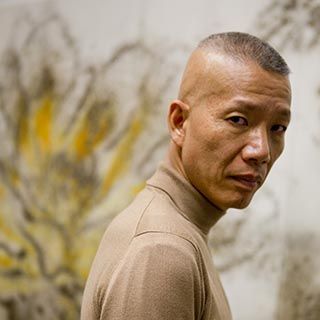Wednesday 30th July 2014

Most of us in the art world have heard of Ai Weiwei, a famous Chinese artist slash dissident who's been making headlines with his challenges to the dictatorially smothering cultural atmosphere in the world's most populous nation. But perhaps fewer have heard of Cai Guo-Qiang, however unfairly, since he's equally controversial and has a remarkably distinguished artistic career. Born in Quanzhou, Fujian Province, China in 1957, he has been living and working in New York City since the mid 1980s, and has a decided penchant for grandiose works of epic scale.
Perhaps inspired by his firsthand experiences of the Cultural Revolution as a teenager, where gunpowder was a common sight and explosions a common sonic backdrop, he experimented early on in his career using gunpowder as an artistic medium, which also earned him his first nods for his multi-part work, Projects for Extraterrestrials. In one especially notable entry in the series that took place at a section of the Great Wall, a stretch of gunpowder six miles long was used to engrave a section of the Gobi Desert with a dragon motif that was a salute to traditional Chinese culture and heritage.
Recently, however, he has begun to become slightly more critical of the current state of affairs in China, specifically with regards to the environmental impacts that the nation has experienced as a result of its rather monumental and incredibly rapid industrial growth over the past 20 years. One of his latest works, titled The Ninth Wave, is being hosted in Shanghai at a gallery named the 'Power Station of Art', and features a moored barge that is populated entirely by taxidermied animals in various poses of sickness and distress. A dig at the Huangpu River's pollution (which grabbed headlines last year over the dumping of 16000 pig carcasses from a farm), the work is intended to raise awareness about the environmental issues associated with industrialisation. Interestingly enough, the Power Station of Art is owned by the Chinese government, and hosts this work despite the fact that it is at least partially critical of the current state of hyperindustrialisation.
Cai has had quite a distinguished career, earning numerous plaudits and awards from various juried competitions, and worked as the Director of Visual and Special Effects at the 2008 Olympic Games in Beijing, a fitting assignment for an artist whose grand scale of work is matched only by his impressive visual flair.
Posted on July 30th 2014 on 07:23pm
 Most of us in the art world have heard of Ai Weiwei, a famous Chinese artist slash dissident who's been making headlines with his challenges to the dictatorially smothering cultural atmosphere in the world's most populous nation. But perhaps fewer have heard of Cai Guo-Qiang, however unfairly, since he's equally controversial and has a remarkably distinguished artistic career. Born in Quanzhou, Fujian Province, China in 1957, he has been living and working in New York City since the mid 1980s, and has a decided penchant for grandiose works of epic scale.
Most of us in the art world have heard of Ai Weiwei, a famous Chinese artist slash dissident who's been making headlines with his challenges to the dictatorially smothering cultural atmosphere in the world's most populous nation. But perhaps fewer have heard of Cai Guo-Qiang, however unfairly, since he's equally controversial and has a remarkably distinguished artistic career. Born in Quanzhou, Fujian Province, China in 1957, he has been living and working in New York City since the mid 1980s, and has a decided penchant for grandiose works of epic scale.



